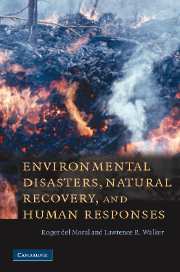Book contents
- Frontmatter
- Contents
- Preface and acknowledgements
- 1 Introduction: a crescendo of destruction
- 2 Natural disturbances: synergistic interactions with humans
- 3 Infertile and unstable habitats
- 4 Infertile and stable habitats
- 5 Fertile and unstable habitats
- 6 Fertile and stable habitats
- 7 The lessons learned
- Glossary
- Illustration credits
- Index
- Plate section
Preface and acknowledgements
Published online by Cambridge University Press: 11 September 2009
- Frontmatter
- Contents
- Preface and acknowledgements
- 1 Introduction: a crescendo of destruction
- 2 Natural disturbances: synergistic interactions with humans
- 3 Infertile and unstable habitats
- 4 Infertile and stable habitats
- 5 Fertile and unstable habitats
- 6 Fertile and stable habitats
- 7 The lessons learned
- Glossary
- Illustration credits
- Index
- Plate section
Summary
Each day we are bombarded with news of natural disturbances. Volcanoes rain unimaginable destruction down on mountain villages, hurricanes and tsunamis ravage coastal communities and fires turn lush forests into ashen specters. Such violent events are fundamental, unavoidable parts of the global environment that in the long term restore and rejuvenate the landscape. In the short term, societies must respond to mitigate the devastation.
Human societies are also assailed by silent disturbances that rarely merit mention in the media. Dunes creep out of a desert to swallow an oasis. Exotic species of shrubs invade grazing land. Lake levels slowly fall, eliminating unique biota and cultures. As our numbers increase, humans have unavoidably become a new form of disturbance. We rival volcanoes, floods, dunes and glaciers in the intensity of our impacts. Our actions magnify other disturbances. Grazing gradually turns steppes to deserts and agriculture impoverishes the land. Our industries pollute in both subtle and more blatant ways that merely reduce productivity or poison ecosystems.
Unlike most natural disturbances, human impacts continue to intensify and become more widespread. Worse, as populations burgeon into ever more sensitive habitats, the effects of natural disasters are becoming increasingly devastating.
We are both academic plant ecologists who have spent most of our careers studying ecosystems damaged by nature and by man. We worry greatly that the natural world is shrinking, losing its ability to sustain biodiversity and, indeed, the human species.
- Type
- Chapter
- Information
- Publisher: Cambridge University PressPrint publication year: 2007



